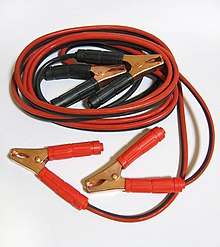Crocodile clip
When manufactured for electronics testing and evaluation, one jaw of the clip is typically permanently crimped or soldered to a wire, or is bent to form the inner tubular contact of a ~4 mm (0.16 in) female banana jack, enabling quick non-permanent connection between a circuit under test and laboratory equipment or to another electrical circuit.'jump leads') are capable of delivering hundreds of Amperes of current needed to directly power an automobile starter motor, or to transfer energy from a charged lead–acid battery to a discharged one.[2] The success of the crocodile clips is largely credited to Charles Kettering's invention of the electric self-starter for motor vehicles.As automobile manufacturers began using this technology initially intended for Cadillacs, a need was produced for something that could connect batteries in storage to a charger.[8] The United States Defense Logistics Agency specifies several types of electrical clips in Commercial Item Description (CID) A-A-59466.



jumper cablesSquare Dspringelectrical connectioncrocodilealligatorelectrical cablebatteryClothespinKelvin clip4-wire measurementbanana jackelectrical circuitlaboratorycopperelectrical resistancelead–acid batterylightbulbinsulationWestinghouse Electric Corporationelectric self-starterCadillacsautomobilesmotorcyclesdentalfencinggluingsolderingHelping handsroach clipcannabisnipple clampheat sinkWayback Machine